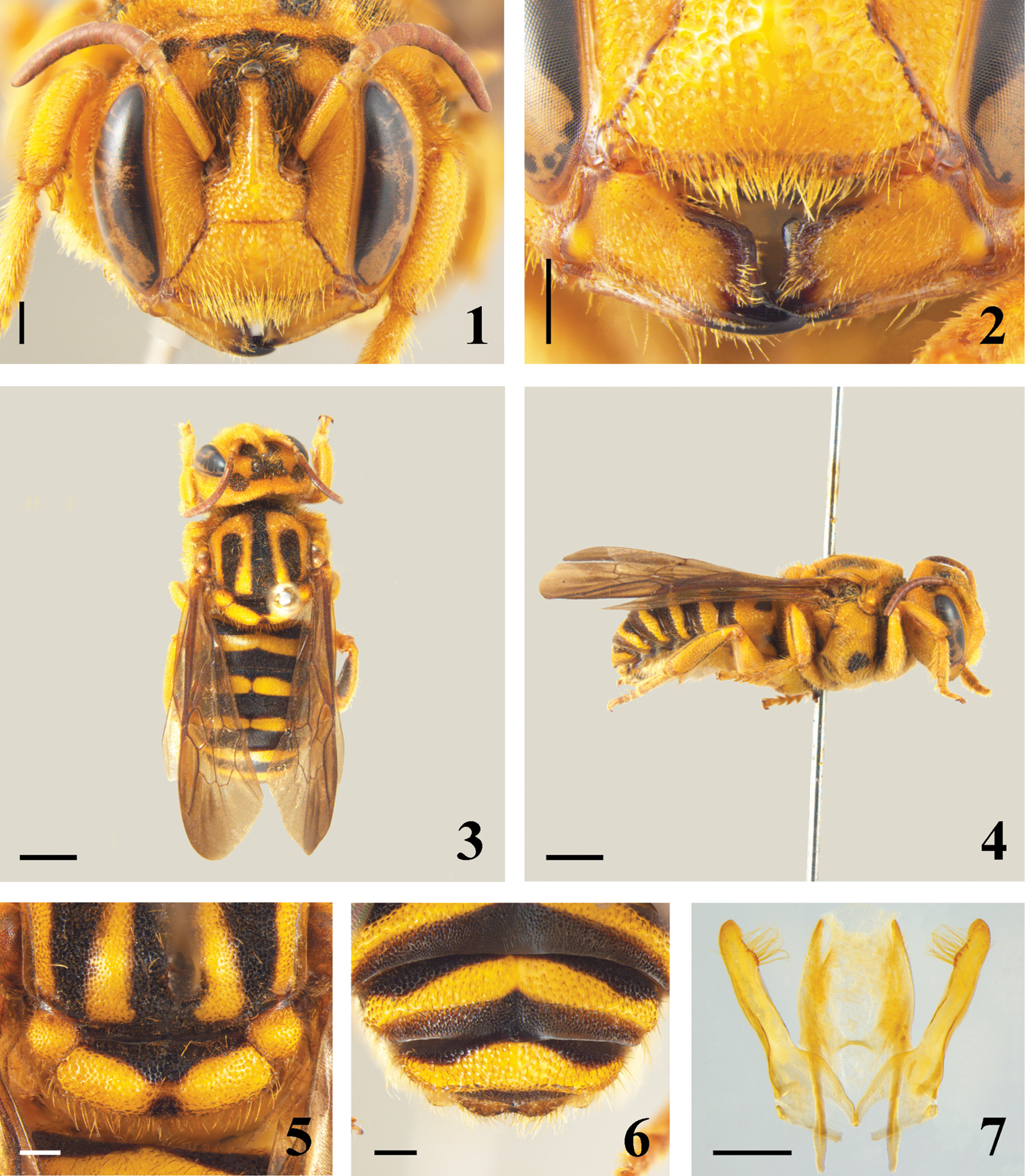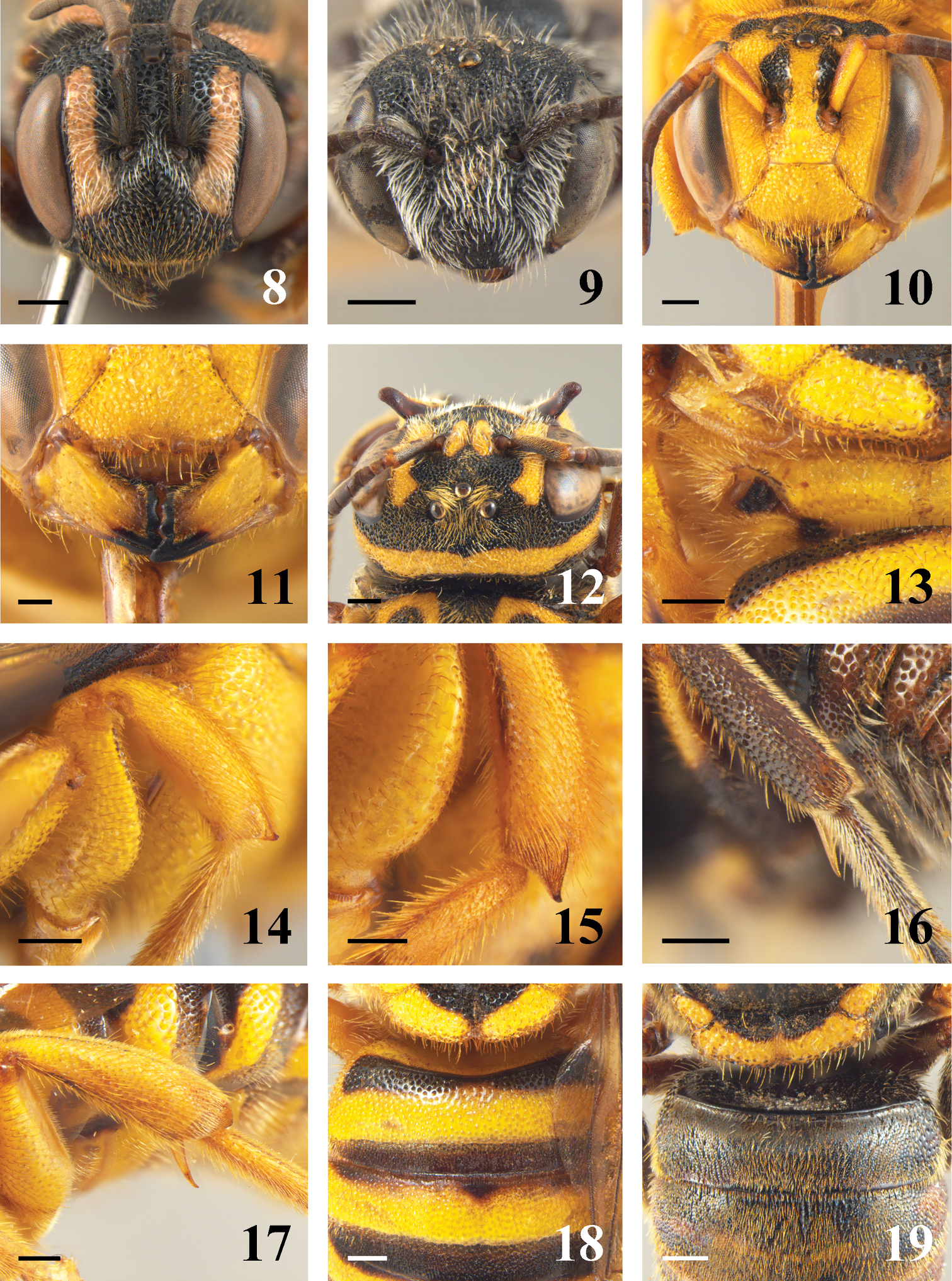






(C) 2012 Danúncia Urban. This is an open access article distributed under the terms of the Creative Commons Attribution License 3.0 (CC-BY), which permits unrestricted use, distribution, and reproduction in any medium, provided the original author and source are credited.
For reference, use of the paginated PDF or printed version of this article is recommended.
Rhynostelis Moure & Urban is a monotypic cleptoparasitic neotropical anthidiine genus currently known from two females. Herein, we describe and illustrate for the first time the male and its genitalia and it is confirmed that Rhynostelis parasitizes nests of Eufriesea. An identification key to the genera of cleptoparasitic anthidiine from the Neotropical region is also presented.
Anthidiini, Brazil, cleptoparasitism, host, taxonomy
Cleptoparasitism is a common behavior among species of Anthidiini and presumably evolved multiple times within the tribe (
Little is known about the biology of these cleptoparasitic bees. In some genera, as Hoplostelis and Dolichostelis, the female enters the nest of a host and kills its eggs and/or larvae. In other groups, such as Stelis, the female lays her eggs on the nest while still open and the young larva has mandibles adapted to kill the host egg or larva (
Rhynostelis consists of a single species, Rhynostelis multiplicata (Smith, 1879), which is known from two female specimens collected on the State of Amazonas, Brazil. Herein, we present an updated diagnosis of Rhynostelis, describe and illustrate the male of Rhynostelis multiplicata and, based on two specimens collected from a trap-nest, we record the orchid bee Eufriesea laniventris (Ducke, 1902) as its host. A key to all neotropical cleptoparasitic anthidiine genera is also provide.
Morphological terminology follows
http://species-id.net/wiki/Rhynostelis
Figs 1–7, 15, 17Diagnosis. Mandibles with only apical tooth elongated, upper distal angle rounded (Fig. 2); clypeus protuberant, with a basal tubercle at middle; supraclypeal area protuberant (Fig. 1); scutum and scutellum bigibbous; axillae and dorso-ventral area of mesepisternum gibbous (Figs 3, 5); distal tergum short and sinuous at middle (Fig. 6); sternum sixth with laminar rounded, lateral projections.
Mandibles with distal margin almost straight, only with apical tooth elongated; upper distal angle slightly marked, condylar carina elevated and strongly laminated, slightly wider at base (Fig. 2). Clypeus protuberant with median basal tubercle elongated, extended in low irregular carina in basal half, apex depressed without projections, not exceeding labrum, covered by many long hairs. Labrum weakly bilobed near clypeal base. Supraclypeal area with wide, somewhat flat median carina; frons with long, well marked carina. Juxtantennal carina laminated, ventrally short, not arising at base of antennal sockets and extending upward (Fig. 1). Scutum and scutellum bigibbous; axillae gibbous; base of propodeum with irregular foveae (Fig. 3, 5). Omaulus lamellate, almost extending ventrally; mesepisternum with gibbous area near mesocoxal cavity. Fore and middle tibiae with midapical spine on outer surface (Fig. 15); arolia present. Fifth and sixth terga with transverse, median low carina; sixth tergum with apical projection at middle; distal tergum slightly emarginated at apex (Fig. 6). Second sternum enlarged, with apex weakly emarginated at middle, with long pilosity at apex; third to fifth sterna with dense apical pilosity, laterally with longer and curved hairs; sixth sternum with distal margin almost straight, with large, angled, laminar, lateral projections subapically.
Genitalia. Gonostylus slightly longer than penis valves; apical half with dense and long pilosity on inner margin; apex rounded, laterally slightly convex. Gonobase incomplete dorsally, only visible laterally (Fig. 7).
http://species-id.net/wiki/Rhynostelis_multiplicata
Figs 1–7, 15, 17Integument black, with wide yellow areas in both sexes. Scutum with a large, reverse U-shaped macula; scutellum almost totally yellow; axillae yellow and all terga with yellow bands (Figs 3, 4). Male and female with protuberant clypeus.
Approximate body length 13.29; forewing length 10.45; head width 4.02; head length 3.67; eye length 2.55. Head integument yellow except: distal margin of mandible and apical tooth black; labrum blackened; frons black, bands above superior margin of antennal sockets extending to vertex, including ocelli and finely attached with black spot above compound eyes. Antennae with ventral face of pedicel darkish yellow, remaining segments light brown; dorsal face with scape and pedicel light brown and flagellum amber (Figs 1, 2). Pronotal lobe yellow; scutum black with large reverse U-shaped yellow maculae; scutellum with on yellow gibbous area joined medially by fine yellow band; axillae yellow; metanotum brown and propodeum yellow. Mesepisternum and metepisternum yellow; mesepisternum with discal black spot, metepisternum with ventral area black. Tegula amber and wing membrane brown. Legs almost totally yellow; middle tibiae with internal darkish area and hind tibiae with large internal darkish area (Figs 3, 4, 5). Terga black; basal tergum with yellow band slightly angled at middle; second to fourth with large yellow band, slightly narrower and slightly interrupted medially; fifth tergum with yellow band emarginated at middle on posterior margin; sixth tergum with yellow band, wider medially; distal tergum with subapical yellow band and blackish margin (Fig. 6). Two basal sterna yellow, with large translucent margin; third to fifth yellow with black infumated area on apical half; sixth sternum with large median black apical spot.
Pubescence. Light yellow with predominantly short hairs (less than ocellus diameter). Pilosity longer and denser among ocelli, above antennal sockets and clypeus apex. Hairs of mesepisternum little longer than mesoscutum, curved on scutellum and propodeum. Fore leg with coxa and trochanter covered by dense pilosity. Third to fifth sterna with apical dense and long slight curved hairs.
Sculpturing. Head finely punctate with sparser punctures on clypeal protuberance and at supraclypeal area. Mandibles with punctures smaller than that of head. Mesoscutum with integument microreticulated, punctures deeper than head. Gibbous area of mesepisternum with larger and sparser punctures; distance between punctures at least half width a puncture diameter. Punctures of terga fine and shallow; punctures on yellow bands larger and sparser than those on black areas.
Material examined. BRAZIL, Pará, Belém: one male, “IPEAN [Instituto de Pesquisas e Experimentação Agropecuária do Norte, Belém] / 105-2 / EU” (DZUP); and one female “IPEAN / 105-1/ EU” (DZUP). Amazonas, Manaus: one female “Proj. DBFF.WWF/ Manaus-AM/ Brasil 04/11/89 / M. B. V. Garcia (DZUP).
Remarks on the female from Pará. Approximate body length 16.13; forewing length 12.38; head width 4.90; length head 4.16, eye length 3.18. Integument predominantly yellow. The female differs from the male as follows: black maculae on vertex and frons larger than in male. All terga with yellow bands; basal tergum with complete band; second and third terga with bands slightly interrupted at middle; fourth tergum with band interrupted anteriorly only at middle, fifth tergum with band interrupted only posteriorly at middle; sixth tergum with subapical band and blackish margin. All sterna yellow; distal sternum with medioapical spot and black margin. The female collected in Manaus is a little smaller than the female from Belém and the integument of the head is darker and with irregular macula. Such differences in color might be caused by some chemical product used during collection or preservation.
Host records. Urban and Moure (1995) commented that one female of Rhynostelis multiplicata emerged from a test-tube placed on a termite nest where an orchid bee was previously seen (possible Eufrisea pulchra (Smith, 1854)). However, the record of the host was never confirmed. The specimens from Belém studied herein emerged from one nest of Eufriesea laniventris (Ducke, 1902), (DZUP), according the identification of Dr. Gabriel A. R. Melo. Thus, the cleptoparasitism of Rhynostelis multiplicata on orchid bees of the genus Eufriesea is confirmed.
Male of Rhynostelis multiplicata. 1head in frontal view 2 detail of mandibles 3 dorsal view 4 lateral view 5 detail of scutellum 6 apex of metasoma 7 male genitalia in dorsal view. Scale line = 0.5 mm (Figures 1–2, 5–7). Scale line = 2.0 mm (Figures 3–4).
8–10 head in frontal view of female. 8 Dolichostelis louisae 9 Stelis lateralis 10 Melostelis amazonensis 11 details of mandibles of Melostelis amazonensis 12 vertex of Hoplostelis bilineolata 13 fovea of propodeum of Melostelis amazonensis 14–15 middle tibia of female 14 Melostelis amazonensis 15 Rhynostelis multiplicata 16–17 hind tibia of female 16 Hoplostelis bilineolata 17 Rhynostelis multiplicata 18–19 details of first tergum of metasoma of female 18 Melostelis amazonensis 19 Hoplostelis bilineolata. Scale line = 0.5 mm (Figures 8–19).
| 1 | Juxtantennal carina absent; middle tibia with two widely separated apical spines | 2 |
| – | Juxtantennal carina present; middle tibia with one apical spine, or subapical carina | 4 |
| 2(1) | Hind tibia with subapical spine near posterior margin, sometimes completely hidden by dense hairs; hind basitarsus with carina along inner dorsal angle, separated from margin by a longitudinal depression | Heterostelis |
| – | Hind tibia without subapical spine; hind basitarsus without carina | 3 |
| 3(1) | Anterior surface of mesepisternum with punctures sparser than on lateral surface; omaulus carinate; interalveolar area short and protuberant (Fig. 8). Male: third sternum with pair of translucent lobes; forth sternum with two median projections | Dolichostelis |
| – | Mesepisternum uniformly punctate; omaular carina absent; interalveolar area flat (Fig. 9). Male: third sternum not modified and fourth sternum with a setose medioapical projection | Stelis |
| 4(1) | Body relatively elongated; small-sized species. Integument coarsely punctate; pilosity between ocelli not differentiated from remaining areas of head | Austrostelis |
| – | Body robust, metasoma almost globose, large species (Fig. 3, 4). Integument with fine to moderate-sized punctures; pilosity among ocelli longer than in remaining areas of head (Fig. 12) | 5 |
| 5(4) | Scutellum laterally with laminate distal margin, with punctures at least twice as larger as those on scutum; hind tibia without flat apical projection on outer surface (Fig. 16); basal tergum with transverse carina (Fig. 19) | Hoplostelis |
| – | Scutellum without laminate projection, with punctures about as large as those on scutum; hind tibia with flat apical projection on outer surface (more developed in females) (Fig. 17); basal tergum without carina (Fig. 18) | 6 |
| 6(5) | Frons not carinate; clypeus without basal tubercle and with two apical projections (Fig. 10). Mesosoma not gibbous; postspiracular fovea drop-shaped, microreticulated, coarsely punctuate and with irregular alveoli (Fig. 13). Female: mandible without bifurcated condylar carina and without protuberance near anterior articulation (Fig. 11); fore and middle tibiae with apical spine as long as half width of median ocellus diameter (Fig. 14) | Melostelis |
| – | Frons carinate; clypeus with basomedian tubercle and without apical projections (Fig. 1). Scutum and scutellum bigibbous (Fig. 5); postspiracular fovea rectangular and with regular alveoli. Female: mandible with bifurcated condylar carina elevated and with protuberance near anterior articulation; fore and middle tibiae with apical spine as long as a diameter of median ocellus (Fig. 15) | Rhynostelis |
We are grateful to Dr. Domiciano Dias for the loan and donation of the specimens of Rhynostelis multiplicata. We would like to thank Dr. Gabriel A.R. Melo for identification of Eufriesea laniventris and information about the trap-nest. We also thank Vitor A. Nardino (Rede Paranaense de Coleções Biológicas – Taxon Line Project) for the photographs used here; Dr. Paschoal C. Grossi and Dr. Victor H. Gonzalez for the English corrections and comments of an earlier version of the manuscript. This is the contribution number 1883 of the Departamento de Zoologia, Universidade Federal do Paraná. DRP received a fellowship grant by CNPq, process number 163133/2011-5.

